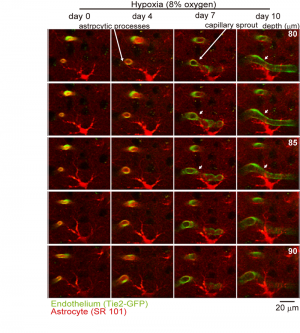Visualizing real-time development of capillary networks in adult brains

The advancement of microscopic photoimaging techniques has enabled the visualization of real-time cellular events in living organs. The brain capillary network exhibits a unique feature that forms a blood-brain barrier (BBB), which is an interface of vascular endothelial cells that control the traffic of substances from the bloodstream into the brain. Damage and disruption to the BBB are implicated in contributing to the pathogenesis and progression of neurodegenerative disorders such as Alzheimer's and epilepsy. However, the cellular interactions present in the BBB are incredibly difficult to study in vivo, so understanding of these mechanisms in living brains is limited.
Now, Kazuto Masamoto and co-workers at the University of Electro-Communications in Tokyo, National Institute of Radiological Sciences, and Keio University School of Medicine, have used 4D live imaging technology to study the effects of hypoxia (a deprivation of oxygen) on the BBB plasticity in live adult mice.
The team focused their attention on how the BBB plastic changes work against hypoxia, looking in particular at the endothelial cells and their communications to the neighboring astrocytes - interactions which take place in controlling the BBB traffic to fulfill neural demands. Using genetically-modified mice with endothelial cells that express green-fluorescent protein, Masamoto and colleagues imaged the real-time changes of BBBs before and during a three-week period of hypoxia in adult mouse cortex.
Their results showed that the capillaries in the BBB, which prior to hypoxia showed no signs of activity, began to sprout new blood vessels which in places formed new networks together. The neighboring astrocytes reacted quickly to wrap the outside of the new vessels, activity which the researchers believe helps stabilize the BBB traffic and integrity.
Further investigations into the molecular mechanisms that control BBB plasticity are expected to lead to advances in treatment of neurodegenerative disorders and cerebral ischemia, and thus provide an effective way for preventing BBB dysfunction in diabetes, hypertension, and aging.
More information: Kazuto Masamoto, et al. "Microvascular sprouting, extension, and creation of new capillary connections with adaptation of the neighboring astrocytes in adult mouse cortex under chronic hypoxia." Journal of Cerebral Blood Flow & Metabolism 34, 325-331 (February 2014) | DOI: 10.1038/jcbfm.2013.201



















